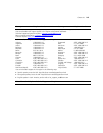242 APPENDIX F: GLOSSARY
Remote
Authentication
Dial-in User Service
(RADIUS)
RADIUS is a logon authentication protocol that uses software running
on a central server to control access to RADIUS-compliant devices on
the network.
Remote Monitoring
(RMON)
RMON provides comprehensive network monitoring capabilities. It
eliminates the polling required in standard SNMP, and can set alarms on
a variety of traffic conditions, including specific error types.
Rapid Spanning Tree
Protocol (RSTP)
RSTP reduces the convergence time for network topology changes to
about 10% of that required by the older IEEE 802.1D STP standard.
Secure Shell (SSH) A secure replacement for remote access functions, including Telnet. SSH
can authenticate users with a cryptographic key, and encrypt data
connections between management clients and the switch.
Routing Information
Protocol (RIP)
The RIP protocol seeks to find the shortest route to another device by
minimizing the distance-vector, or hop count, which serves as a rough
estimate of transmission cost. RIP-2 is a compatible upgrade to RIP. It
adds useful capabilities for subnet routing, authentication, and
multicast transmissions.
Simple Network
Management
Protocol (SNMP)
The application protocol in the Internet suite of protocols which offers
network management services.
Spanning Tree
Protocol (STP)
A technology that checks your network for any loops. A loop can often
occur in complicated or backup linked network systems. Spanning Tree
detects and directs data along the shortest available path, maximizing
the performance and efficiency of the network.
Terminal Access
Controller Access
Control System Plus
(TACACS+)
TACACS+ is a logon authentication protocol that uses software running
on a central server to control access to TACACS-compliant devices on
the network.
Transmission Control Protocol/Internet Protocol (TCP/IP)
Protocol suite that includes TCP as the primary transport protocol, and
IP as the network layer protocol.
Trivial File Transfer
Protocol (TFTP)
A TCP/IP protocol commonly used for software downloads.
User Datagram
Protocol (UDP)
UDP provides a datagram mode for packet-switched communications. It
uses IP as the underlying transport mechanism to provide access to


















